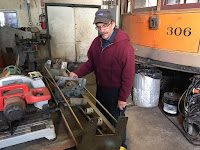I was out at IRM on a Saturday, for a change, and with temperatures around 50 degrees I was able to get in some painting on the left side of Lake Shore Electric 150. Today the color of choice was yellow, or at least light yellow, which is the color along the window line. The rear half of the car had already received a first coat of yellow but I was able to finish things up all the way to the front corner of the car. A second coat will be needed but this definitely improves the car's appearance. The requisite before-and-after shots:
Obviously there's plenty more to do including more orange on the front end of the car. The belt rail on the left side also still needs to be painted tile red. But it's getting there. So while we're in the shop to clean up the paint brush, let's see what else is happening.
Eric and Lorne were both out working on the Cleveland PCC, and here Eric is shown with the car's original sign box. It's got an interesting history: Cleveland used single-roll sign boxes but with the crank to the operator's left, rather than to the operator's right as is (apparently) more common. However Toronto used split sign boxes with two rolls and the cranks on the operator's right. So when the car went to Toronto, they added a new divider in the middle of the box, moved the crank, and added another crank for the second roll. This box was pretty deteriorated and Eric had planned to use one out of a Shaker car we parted out some years back, but it turns out that won't work right because the crank is on the right and that box only has five light bulbs, not the six that our Cleveland car had. So he's going to make one complete sign box out of this original one and components from the Shaker spare. Confused yet? Don't worry, Eric's on it - and like the rest of the car, it's going to look better than new when done!
And speaking of "better than new," Tim Peters is at it again. Here he is shown with a motorman's cab door (foreground) and side door from wooden "L" car 1754. He isn't taking that car on as a full restoration, but a number of its doors and windows are badly deteriorated so he is going to repair and rebuild them in the shop. The 1754 is a pretty historic car, the only surviving Jewett from the Chicago elevated and an unusual example of a wood car that was rebuilt mechanically and electrically with equipment identical to what was used on the 4000-series steel cars.
And then I caught the Steam Department switching CB&Q 637, shown here; I think it was headed to one of the new barns at the south end. This is really a neat engine; these K-2 ten-wheelers were common on the line through Macomb, where I went to college, and are emblematic of the 1890s Belpaire firebox, cab-over-firebox CB&Q design standard.
Before I headed out for the evening, I caught a somewhat unusual operation. Joel, Nick E, Thomas and Richard were working on finishing the annual inspection of ComEd 4 and wanted to drain the oil out of the compressors - something that hasn't been done in recent years. The reason is that the locomotive's two compressors (shown above) are mounted about an inch over the cab floor with no floor drain underneath the oil sump drain. What to do, what to do...
Step one, run the locomotive over to the super-elevated curve at Depot Street so that the locomotive is leaning...
Then have Thomas open the drain plug over one end of a trough hurriedly fashioned out of a piece of thin sheet metal while Richard holds a five-gallon bucket at the downhill end and Joel looks on dubiously.
Don't try this at home, kids - leave it to the professionals!
...what, you ask, is a "yellow fellow?" Why it's an Avery separator, of course!









And it worked like a charm.
ReplyDeleteAvery --- "The best proven grain saver built" --- direct from Peoria IL to you.
ReplyDeleteThe B & G farmer